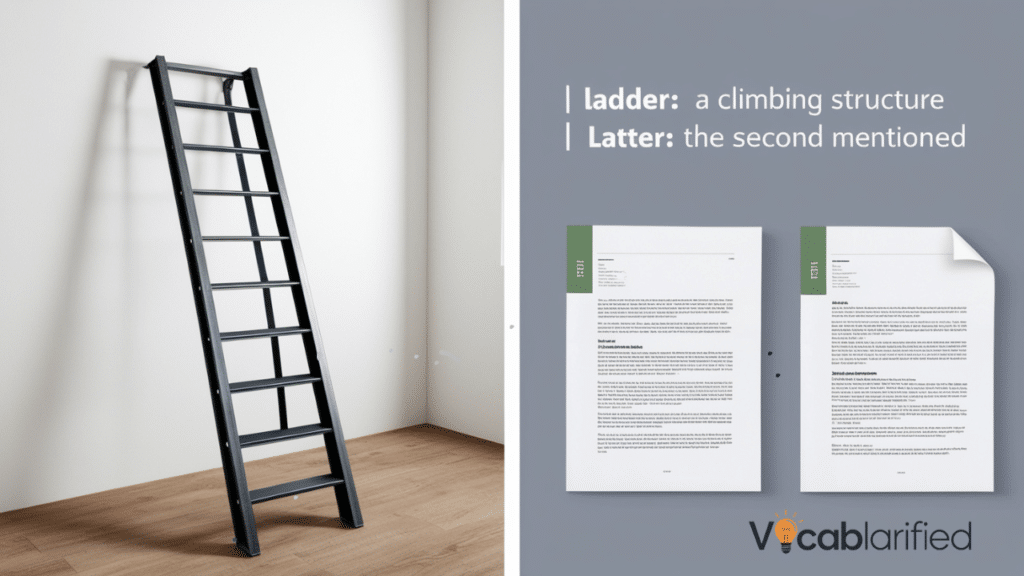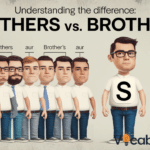Clear communication forms the backbone of effective writing, and choosing the right words can make all the difference.
When it comes to everyday language usage, few word pairs create as much confusion as “ladder” and “latter.” Let’s embark on a journey to master these commonly confused terms and enhance our writing precision.
The Core Definitions
Understanding the difference between ladder and latter begins with their fundamental definitions. A ladder refers to a physical climbing structure with rungs or steps, while latter indicates the second or final item in a sequence of two. This distinction might seem straightforward, but their applications extend far beyond these basic meanings.

Professional Context Applications
In the corporate world, both terms find unique applications. Sarah Thompson, a career counselor at CareerBoost Inc., often discusses the metaphorical career progression ladder with her clients. Meanwhile, in formal business communication, the term “latter” frequently appears when discussing multiple options or proposals.

Here’s a comprehensive look at how these terms appear in various professional scenarios:
| Business Scenario | Ladder Usage | Latter Usage |
|---|---|---|
| Email Communication | Discussing career growth | Referring to previous points |
| Project Planning | Safety equipment lists | Option selection |
| HR Documentation | Professional development | Policy references |
| Risk Assessment | Emergency exits | Comparative analysis |
| Training Materials | Construction safety | Course selection |
| Meeting Minutes | Facility maintenance | Decision records |
| Strategy Documents | Market positioning | Alternative choices |
| Annual Reports | Growth metrics | Performance comparison |
| Client Proposals | Service hierarchy | Option preferences |
| Internal Memos | Safety protocols | Policy amendments |
You Might Like: Cubical Or Cubicle | Which One Fits Your Space?
Real-World Applications
Consider this email exchange between a construction site manager and a safety officer:
“Dear Alex,
Regarding the equipment inspection scheduled for tomorrow, we need to focus on two areas: scaffolding and access points. The ladder installation in Block C requires immediate attention as several rungs show signs of wear.”
Now compare it with this excerpt from a business proposal:
“We’ve analyzed both the immediate expansion plan and the phased growth strategy. The latter approach aligns better with our current resources and market conditions.”
Common Confusions Explored
The prevalence of these terms in business communication necessitates a clear understanding of their contextual applications. Here’s an analysis of their usage patterns:
| Context | Word Choice | Example Application |
|---|---|---|
| Career Growth | Ladder | Professional advancement |
| Sequential Reference | Latter | Previous mentions |
| Physical Equipment | Ladder | Construction tools |
| Time References | Latter | Recent events |
| Organizational Structure | Ladder | Corporate hierarchy |
| Document References | Latter | Prior statements |
| Safety Protocols | Ladder | Emergency exits |
| Decision Making | Latter | Option selection |
| Training Programs | Ladder | Skill progression |
| Report Writing | Latter | Data comparison |
You Might Like: Addition Or Edition | Understanding The Key Differences
Contextual Meanings in Practice
When discussing contextual meanings of ladder and latter, professional scenarios offer rich examples. In project management, a team might discuss both the physical ladders needed for site access and the latter phases of implementation in the same meeting. This dual usage highlights the importance of clear context.
Industry-Specific Applications
Different industries leverage these terms distinctively. Consider how they appear in various professional contexts:
| Industry | Ladder Context | Latter Context |
|---|---|---|
| Construction | Safety equipment | Project phases |
| Finance | Investment tiers | Portfolio analysis |
| Education | Academic progression | Course selection |
| Healthcare | Emergency access | Treatment options |
| Technology | System architecture | Version control |
| Retail | Store displays | Inventory choices |
| Manufacturing | Production access | Process selection |
| Consulting | Service levels | Client options |
| Real Estate | Property access | Offer comparison |
| Legal | Court hierarchy | Case references |
Professional Writing Guidelines
In professional documentation, understanding when to use ladder versus when to use latter becomes crucial. Technical writers must be particularly mindful of these distinctions when creating manuals or procedural documents.
Clear Communication Practices
Effective business writing relies on precision. When making a choice between two options, writers must ensure their usage of “latter” clearly references the second of two previously mentioned items. Similarly, discussions of organizational advancement should properly employ the metaphorical ladder concept.
Consider this performance review excerpt:
“Michael demonstrates strong potential for advancement. His technical expertise and leadership qualities position him well on the corporate ladder. Between his project management skills and strategic thinking, the latter proves particularly valuable in his current role.”
Practical Examples Table
Understanding comes through exposure to practical examples:
| Communication Type | Example with Ladder | Example with Latter |
|---|---|---|
| Business Email | Safety inspection of warehouse ladders | Choosing the latter proposal |
| Project Report | Installation of fire escape ladders | Implementation of latter phase |
| Meeting Notes | Discussing career ladder programs | Reference to latter suggestion |
| Policy Document | Ladder safety protocols | Latter policy amendment |
| Training Manual | Proper ladder usage guide | Latter exercise completion |
| Risk Assessment | Ladder maintenance schedule | Latter risk category |
| Strategic Plan | Market ladder positioning | Latter growth strategy |
| Client Contract | Equipment ladder specifications | Latter payment terms |
| Team Memo | Ladder inspection reminder | Latter deadline extension |
| Annual Review | Career ladder advancement | Latter performance metric |
This comprehensive exploration of ladder and latter showcases their vital role in professional communication. Understanding their proper usage enhances writing clarity and effectiveness across all business contexts.
You Might Like: Free Reign Or Free Rein | Which One Should You Use?
Mastering Corporate Communications
In the realm of business writing, mastering the subtle distinctions between commonly confused words elevates your professional image. The difference between ladder and latter becomes particularly crucial in corporate communications where precision dictates success.
Digital Communication Excellence
Modern business relies heavily on email and digital messaging. Understanding proper word usage in these contexts helps prevent misunderstandings and maintains professional credibility.
Let’s explore how these terms manifest in various digital communications.
| Email Purpose | Ladder Reference Example | Latter Reference Example |
|---|---|---|
| Project Updates | Maintenance of safety ladders | Follow-up on latter proposal |
| Team Announcements | Career ladder updates | Latter policy changes |
| Client Communications | Equipment specifications | Latter pricing option |
| Internal Memos | Access ladder installations | Latter budget revision |
| Safety Bulletins | Ladder inspection protocols | Latter safety measure |
| HR Notifications | Promotion ladder changes | Latter benefit package |
| IT Updates | Server rack ladder access | Latter system upgrade |
| Facility Notices | Emergency ladder checks | Latter maintenance schedule |
| Training Invites | Ladder safety certification | Latter workshop date |
| Policy Updates | Ladder usage guidelines | Latter compliance requirement |
Professional Context Applications
Consider this email from a department head discussing organizational changes:
“Dear Team,
We’re implementing two new initiatives: a revised career progression pathway and an updated benefits package. The latter will take effect immediately, while our new ladder of advancement opportunities will roll out gradually.”
Industry-Specific Implementations
Different sectors employ these terms in unique ways, reflecting their particular needs and contexts:
| Industry Sector | Ladder Implementation | Latter Application |
|---|---|---|
| Investment Banking | Trading ladder strategy | Latter market analysis |
| Healthcare Services | Emergency access ladders | Latter treatment protocol |
| Software Development | Code deployment ladder | Latter version release |
| Retail Operations | Store fixture ladders | Latter sales strategy |
| Manufacturing | Production line ladders | Latter quality check |
| Logistics | Warehouse access ladders | Latter shipping option |
| Education | Academic achievement ladder | Latter semester plans |
| Construction | Safety ladder protocols | Latter phase completion |
| Research | Career research ladder | Latter study findings |
| Hospitality | Service ladder training | Latter booking option |
Contextual Usage Guidelines
Understanding contextual meanings of ladder and latter enhances communication effectiveness. Business professionals must navigate these terms carefully in various situations.
Professional Document Standards
When crafting business documents, precision in word usage becomes paramount. Here’s how these terms appear in different professional documents:
| Document Type | Ladder Context | Latter Context |
|---|---|---|
| Annual Reports | Growth ladder metrics | Latter quarter performance |
| Strategic Plans | Market ladder position | Latter strategy implementation |
| Safety Manuals | Ladder maintenance guide | Latter safety protocol |
| HR Policies | Career ladder framework | Latter benefit option |
| Project Briefs | Access ladder specs | Latter milestone completion |
| Training Materials | Ladder safety modules | Latter certification level |
| Legal Contracts | Equipment ladder standards | Latter agreement clause |
| Quality Reports | Inspection ladder checklist | Latter compliance phase |
| Budget Documents | Cost ladder structure | Latter expense category |
| Risk Assessments | Ladder safety ratings | Latter risk scenario |
Clear Communication Examples
The following email exchange demonstrates proper usage in a professional setting:
“Hi Jennifer,
I’ve reviewed both the quarterly sales report and the market analysis. The latter provides compelling evidence for our expansion strategy. Speaking of growth, your team’s position on the corporate ladder continues to strengthen with these impressive results.”
Application in Business Writing
Professional writers must understand when discussing climbing structure versus making a choice between two options. This knowledge ensures precise and effective communication.
Consider this project management message:
“Team,
The current phase requires both updating our emergency ladder systems and revising our evacuation procedures. Between the physical improvements and protocol updates, the latter demands immediate attention.”
Communication Best Practices
Excellence in everyday language usage requires understanding both literal and metaphorical applications. Here’s an analysis of usage patterns in business communications:
| Communication Channel | Ladder Reference | Latter Reference |
|---|---|---|
| Board Presentations | Growth ladder charts | Latter performance data |
| Team Meetings | Safety ladder updates | Latter agenda item |
| Client Calls | Service ladder options | Latter proposal point |
| Training Sessions | Ladder safety demos | Latter module review |
| Performance Reviews | Career ladder progress | Latter goal achievement |
| Strategy Sessions | Market ladder position | Latter option analysis |
| Safety Briefings | Ladder inspection results | Latter protocol update |
| Project Updates | Installation ladder timeline | Latter phase status |
| Budget Reviews | Cost ladder structure | Latter expense report |
| Quality Audits | Ladder compliance check | Latter finding review |
Professional Growth Applications
In discussing professional development, both terms find regular use. The corporate ladder represents advancement opportunities, while latter often appears in comparing development options.
This comprehensive exploration of professional applications demonstrates the importance of mastering these terms for effective business communication. Understanding their proper usage enhances clarity and professionalism across all business contexts.
Academic Writing Precision
Academic writing demands meticulous attention to word usage and precision. Understanding the nuances between terms like ladder and latter becomes crucial for scholarly communication and research documentation.
Research Writing Applications
In academic contexts, both terms serve distinct purposes. While ladder often appears in methodology descriptions and theoretical frameworks, latter frequently connects related concepts in scholarly arguments. Let’s examine their applications across different academic disciplines:
| Academic Field | Ladder Application | Latter Usage Examples |
|---|---|---|
| Psychology | Social status ladder | Latter behavioral pattern |
| Sociology | Socioeconomic ladder | Latter cultural phenomenon |
| Economics | Price ladder analysis | Latter market trend |
| Biology | DNA ladder structure | Latter gene expression |
| Engineering | Load-bearing ladders | Latter design iteration |
| Chemistry | Electron ladder model | Latter reaction phase |
| Physics | Energy ladder states | Latter quantum effect |
| Mathematics | Probability ladder | Latter theorem application |
| Literature | Narrative ladder theory | Latter textual analysis |
| Philosophy | Conceptual ladder model | Latter ethical argument |
Scholarly Communication Examples
Consider this excerpt from a research methodology section:
“The study employed both quantitative surveys and qualitative interviews. The latter provided rich contextual data about participants’ perceptions of the corporate ladder in modern organizations.”
Theoretical Framework Applications
Understanding how these terms function within theoretical discussions enhances scholarly writing:
| Theory Type | Ladder Concept | Latter Analysis |
|---|---|---|
| Organizational | Career ladder models | Latter development stage |
| Behavioral | Achievement ladder | Latter response pattern |
| Cognitive | Learning ladder theory | Latter processing phase |
| Social | Status ladder dynamics | Latter group interaction |
| Economic | Price ladder strategy | Latter market response |
| Systems | Hierarchy ladder model | Latter feedback loop |
| Educational | Skill ladder progression | Latter learning outcome |
| Developmental | Growth ladder stages | Latter maturation phase |
| Cultural | Social ladder construct | Latter value system |
| Psychological | Maslow’s ladder adaptation | Latter need category |
Research Context Usage
The application of these terms in research writing demonstrates the importance of clear communication and precise terminology:
“Our investigation examined both immediate and long-term effects of organizational change. The latter revealed significant impacts on employee perception of the traditional career ladder.”
Methodological Applications
Research methodologies utilize these terms distinctively across different study types:
| Research Method | Ladder Analysis | Latter Implementation |
|---|---|---|
| Quantitative | Hierarchical ladder scales | Latter statistical test |
| Qualitative | Career ladder interviews | Latter thematic analysis |
| Mixed Methods | Status ladder metrics | Latter integration phase |
| Longitudinal | Progress ladder tracking | Latter time period |
| Case Study | Organizational ladder review | Latter outcome analysis |
| Experimental | Achievement ladder measure | Latter control group |
| Observational | Behavior ladder coding | Latter observation period |
| Survey Research | Attitude ladder scale | Latter response category |
| Action Research | Change ladder implementation | Latter cycle analysis |
| Meta-Analysis | Success ladder criteria | Latter study inclusion |
Conceptual Framework Development
In developing theoretical frameworks, understanding contextual meanings of ladder and latter helps articulate complex ideas:
“The research explores both cognitive development patterns and social influence factors. While the latter shapes individual perspectives, the social ladder concept provides a framework for understanding hierarchical relationships.”
Academic Documentation Standards
Scholarly writing requires precise documentation of common confusions and their resolution:
| Document Type | Ladder Reference | Latter Citation |
|---|---|---|
| Literature Review | Status ladder theory | Latter research finding |
| Methodology Section | Sample ladder design | Latter data collection |
| Results Analysis | Progress ladder metrics | Latter statistical test |
| Discussion Chapter | Career ladder impact | Latter interpretation |
| Theoretical Framework | Conceptual ladder model | Latter construct analysis |
| Data Analysis | Measurement ladder scale | Latter variable testing |
| Conclusions | Achievement ladder findings | Latter recommendation |
| Future Research | Development ladder proposal | Latter research direction |
| Limitations | Assessment ladder constraints | Latter methodology gap |
| Recommendations | Implementation ladder steps | Latter policy suggestion |
Research Impact Considerations
Understanding how these terms affect research communication enhances scholarly impact:
“The study investigated both traditional career advancement and modern workplace dynamics. The latter revealed significant changes in how professionals view the corporate ladder.”
This third section emphasizes the academic applications of these terms, particularly in research and scholarly writing contexts. The careful distinction between ladder and latter proves essential for precise academic communication and theoretical development.
Technical Documentation Standards
Technical writing demands absolute precision in word usage, particularly when dealing with safety-critical equipment like ladders or sequential procedures where latter references are crucial. Understanding these distinctions can literally make the difference in safety protocols and operational procedures.
Safety Documentation Requirements
The proper documentation of ladder specifications and safety protocols represents a critical aspect of technical writing. Every detail must be precise and unambiguous.
| Documentation Type | Ladder Specifications | Latter Protocol Reference |
|---|---|---|
| Safety Manuals | Weight capacity ratings | Latter inspection phase |
| Installation Guides | Mounting requirements | Latter assembly step |
| Maintenance Protocols | Support bracket specs | Latter service interval |
| Emergency Procedures | Access ladder locations | Latter evacuation route |
| Inspection Checklists | Rung spacing standards | Latter compliance check |
| Risk Assessments | Fall protection systems | Latter hazard category |
| Operating Instructions | Placement guidelines | Latter usage warning |
| Quality Control | Material standards | Latter testing phase |
| Training Materials | Usage demonstrations | Latter certification step |
| Compliance Documents | Design requirements | Latter regulation update |
Equipment Specification Examples
Consider this technical specification excerpt:
“The facility requires both fixed and portable access systems. The ladder installation must support 350kg loads, while the latter specification exceeds OSHA requirements for emergency exits.”
Technical Writing Applications
Different industries require specific approaches to documenting climbing structure specifications and procedural references:
| Industry Sector | Ladder Technical Specs | Latter Process Reference |
|---|---|---|
| Manufacturing | Load capacity ratings | Latter quality check |
| Construction | Installation clearances | Latter safety protocol |
| Telecommunications | Tower access systems | Latter signal test |
| Maritime | Marine grade ratings | Latter inspection point |
| Aviation | Service access specs | Latter preflight check |
| Energy | Platform integration | Latter shutdown sequence |
| Mining | Underground access | Latter ventilation step |
| Transportation | Vehicle access points | Latter maintenance phase |
| Agriculture | Silo access systems | Latter cleaning protocol |
| Warehousing | Rack access specs | Latter inventory check |
Procedural Documentation
Understanding when to use ladder versus when to use latter becomes crucial in step-by-step procedures:
| Procedure Type | Ladder Reference | Latter Step Details |
|---|---|---|
| Assembly Guide | Component alignment | Latter fastening phase |
| Safety Protocol | Access point setup | Latter emergency step |
| Maintenance Schedule | Equipment check | Latter service interval |
| Operation Manual | Setup procedure | Latter adjustment phase |
| Quality Control | Inspection points | Latter verification step |
| Training Guide | Usage demonstration | Latter practice session |
| Emergency Response | Access route check | Latter evacuation phase |
| Installation Process | Mounting sequence | Latter testing stage |
| Repair Protocol | Damage assessment | Latter replacement step |
| Testing Procedure | Load test setup | Latter certification check |
Technical Communication Standards
Effective documentation of everyday language usage in technical contexts requires careful attention to detail:
“The facility upgrade involves two critical systems: primary access ladders and emergency escape routes. The latter must integrate seamlessly with existing safety protocols, while each ladder installation requires individual certification.”
Implementation Guidelines
Technical writers must understand both physical specifications and procedural sequences for proper documentation:
| Documentation Focus | Ladder Guidelines | Latter Implementation |
|---|---|---|
| Design Specifications | Material standards | Latter revision note |
| Safety Requirements | Load ratings | Latter compliance update |
| Installation Steps | Mounting details | Latter verification |
| Maintenance Schedule | Service intervals | Latter inspection date |
| Training Requirements | Usage protocols | Latter certification |
| Emergency Procedures | Access points | Latter response step |
| Quality Standards | Testing criteria | Latter approval phase |
| Compliance Records | Safety features | Latter audit finding |
| Operating Parameters | Usage limits | Latter adjustment |
| Inspection Protocols | Check points | Latter documentation |
Technical Review Process
In addressing common confusions, technical documentation must provide clear distinctions:
“Equipment inspection requires both physical examination and documentation review. The latter ensures compliance history, while proper ladder maintenance guarantees operational safety.”
This section emphasizes technical writing applications, particularly in safety-critical documentation. Understanding the distinction between ladder and latter proves essential for clear, unambiguous technical communication that ensures both safety and operational efficiency.
Digital Communication and Social Media Context
In today’s digital age, understanding the proper usage of “ladder” and “latter” extends beyond traditional business and academic contexts into social media and digital marketing communications. The rapid evolution of professional networking platforms has introduced new applications for these terms.
Social Media Professional Context
Professional social media platforms frequently reference career advancement and sequential content, making proper usage crucial:
| Platform Type | Ladder Reference | Latter Usage |
|---|---|---|
| Career ladder posts | Latter update mentions | |
| Corporate Blogs | Success ladder stories | Latter article references |
| Professional Forums | Skill ladder discussions | Latter topic responses |
| Industry Networks | Achievement ladder metrics | Latter trend analysis |
| Company Intranets | Promotion ladder announcements | Latter policy updates |
Content Marketing Applications
Digital marketers must navigate these terms carefully when creating content:
- Infographic hierarchies using ladder concepts
- Blog post sequences referencing latter points
- Social media threads maintaining clear latter references
- Email marketing campaigns discussing career ladders
- Video content explaining advancement ladders
Remote Work Considerations
The shift to remote work has introduced new contexts for these terms:
- Virtual career ladder discussions
- Digital advancement frameworks
- Remote team hierarchy documentation
- Online training sequence references
- Virtual mentorship ladder programs
International Business Communication
Global business contexts require careful attention to these terms across cultures:
| Region | Ladder Concept Adaptation | Latter Usage Guidelines |
|---|---|---|
| Asia Pacific | Career progression ladders | Sequential reference protocols |
| European Union | Professional development structures | Documentation standards |
| North America | Corporate advancement systems | Reference conventions |
| Latin America | Achievement frameworks | Chronological markers |
| Middle East | Organizational hierarchies | Temporal indicators |
Emerging Technology Applications
The technology sector has developed unique applications for these terms in various contexts:
Software Development
- Code deployment ladders
- Testing sequence references
- Development stage documentation
- System architecture hierarchies
- Feature implementation ordering
Artificial Intelligence
The AI field employs these terms distinctively:
- Learning ladder algorithms
- Sequential processing references
- Neural network hierarchies
- Decision tree structures
- Model evolution documentation
Cybersecurity Protocols
Security documentation requires precise usage:
| Security Aspect | Ladder Implementation | Latter Reference |
|---|---|---|
| Access Control | Security clearance ladders | Protocol sequences |
| Risk Assessment | Threat level hierarchies | Mitigation steps |
| Incident Response | Escalation ladders | Response phases |
| Compliance | Security framework tiers | Audit stages |
| Training | Certification levels | Course modules |
Future Trends and Applications
As professional communication continues to evolve, new applications emerge:
Digital Transformation
- Virtual advancement structures
- Online learning progressions
- Digital achievement frameworks
- Remote collaboration sequences
- Cloud infrastructure hierarchies
Sustainable Development
Environmental documentation introduces specific contexts:
- Green certification ladders
- Sustainability achievement frameworks
- Environmental compliance hierarchies
- Conservation project sequences
- Climate action step progressions
Innovation Management
Modern innovation processes require clear terminology:
| Innovation Phase | Ladder Structure | Latter Reference |
|---|---|---|
| Ideation | Development frameworks | Process stages |
| Prototyping | Testing hierarchies | Iteration sequences |
| Implementation | Rollout structures | Deployment phases |
| Evaluation | Success metrics | Assessment stages |
| Optimization | Improvement ladders | Refinement steps |
Conclusion
The distinction between “ladder” and “latter” remains fundamental to effective professional communication across all contexts. As business environments evolve and new communication channels emerge, these terms continue to serve essential functions in conveying both physical structures and sequential references. Understanding their proper usage enhances clarity in traditional business writing while enabling effective communication in emerging digital and technological contexts.
The comprehensive exploration of these terms across various professional settings demonstrates their enduring relevance and the importance of maintaining precise usage. From traditional business documents to cutting-edge digital communications, mastering the proper application of “ladder” and “latter” remains a crucial skill for professional success.
Modern professionals must navigate these terms with increasing sophistication as communication contexts expand and evolve. Whether discussing career advancement, documenting technical procedures, or managing digital transformations, the ability to distinguish and properly employ these terms ensures effective communication and maintains professional credibility.
As we look to the future, the importance of precise language usage in professional contexts will only grow. The continued evolution of business communication across digital platforms, international markets, and emerging technologies demands ongoing attention to these fundamental elements of clear communication. Mastering these distinctions contributes to professional success and effective organizational communication in an increasingly complex and interconnected business world.

Emma Carter is an experienced blogger at Vocablarified. She enjoys helping people expand their vocabulary and improve their language skills. With a warm and approachable writing style, Emma makes learning new words fun and accessible. When she’s not writing, she loves reading books and discovering new phrases to share with her readers. Emma is passionate about making language learning an enjoyable journey for everyone.







